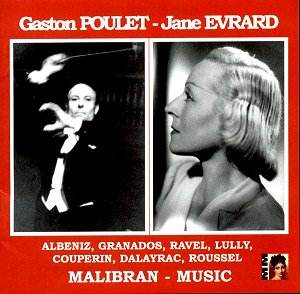Malibran has cultivated a happy knack of conjoining
musical coevals or mutually sympathetic pairings. In the case
of this fascinating disc there was an even greater imperative
– these two violinists were husband and wife. Poulet is by far
the better known and many will recall his name as the young violinist
who premiered Debussy’s 1917 Violin Sonata in the Salle Gaveau
in Paris, the composer accompanying. A serial prizewinner as a
youth he had a duo with Yves Nat, formed his own highly regarded
quartet (on the advice of no less than Fauré) and was encouraged
to pursue a career as a conductor by Toscanini ("You, with
your eyes, you will become a conductor!") He began in Paris,
toured South America, returned to the south of France where he
formed an orchestra in Bordeaux whilst also heading the prestigious
Colonne Orchestra. As a violinist he recorded with his quartet
but made no discs as a soloist. His recording with Ferras of the
Elizalde violin Concerto has recently reappeared on Testament
and older collectors will remember his collaboration with Menuhin
in Saint-Saëns and Poulet’s own highly impressive violinist
son Gérard on Remington. He died in 1974.
His fairly meagre discography has here been supplanted
by what appears to be private recordings made at the Besançon
Festival in 1948. They are in remarkably fine shape and boast
impressive frequency response. It helps in addition that the repertoire
was so congenial to a Frenchman of his generation and as a string
player one who bring colour and expressive breadth and imperishable
style to his performances. He clearly wasn’t a powerhouse conductor
– more a colourist and subtle delineator of orchestral shards
and strands and these performances reflect well on him and the
orchestra. His Albeniz is evocative and brings out some really
individual and fine playing from the strings, the muted trumpets
and percussion (in El Puerto) and the noble rounded brass in El
Corpus en Sevilla where he extracts colour at every turn. There
is strong, snappy rhythm in El Albaicin and plenty of glimmer
and glint. He’s tautly expressive in the Granados and in the Ravel
one can admire the agility of the flutes and brass and the sheer
stylishness Poulet cultivates.
Jeanne Chevalier met Poulet at the Conservatoire
Nationale de Paris and they married in 1912. She was playing in
her husband’s quartet on the famous occasion when Debussy announced
that they were playing his Quartet rather differently from the
way he’d expected but from now on that’s how it should be played.
Gradually Jeanne – or Jane Evrard as she was to become – formed
an all female chamber orchestra that explored early repertoire
(Gretry, Couperin) and also did sterling service by premiering
new work by such as Honegger, Schmidt and indeed the Sinfonietta
by Roussel, which is preserved here in a 1956 radio broadcast
– she’d also recorded it for HMV in the 1930s. Her portion of
the disc highlights those twin strengths; the ancient and the
up-to-date. Her Roussel is resonant and expertly judged, catching
both its saturnine and piquant depths, the twenty-two strings
lithe and lean. Her Lully has plenty of old fashioned charm, dramatic
rallentandi and an audible harpsichord and the Dalayrac is a piece
the Krettly Quartet recorded (probably Evrard knew it from her
own experience in her quartet). The jewel though is the Couperin.
There was something of a mini explosion of interest in Couperin
at the time in Paris; new editions had been published and recordings
were now not entirely uncommon – Landowska led the way but Alice
Ehlers and Yella Pessl all recorded Couperin on the harpsichord
and a number of vocal and instrumental works had been recorded.
Nevertheless in an analogue to Nadia Boulanger’s almost contemporaneous
exploration on record of Monteverdi (which also featured Hugues
Cuénod) this is a most moving exploration of the Troisième
Leçon de Ténèbres. Its ability still to move
is based on the very obvious sincerity and sense of purposeful
delicacy the forces bring to the work, in all their romantic engagement.
Its imperfections seem to me trivial in comparison and the way
in which the solo trumpet courses and winds its way behind the
melismatic chorus is still a thing of wonder.
The notes – in French and English – are by Manuel
Poulet and the disc as a whole sheds fascinating light on a previously
under explored area of French musical life.
Jonathan Woolf
